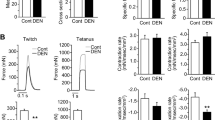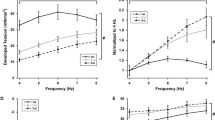Abstract
We have studied the effects of short term denervation followed by reinnervation on the ultrastructure of the membrane systems and on the content of and distribution of key proteins involved in calcium regulation of fast-twitch (FT) extensor digitorum longus (EDL) and slow-twitch (ST) soleus (SOL) muscle fibres. Ischiadic nerve freezing resulted in total lack of neuromuscular transmission for 3 days followed by a slow recovery, but no decline in twitch force elicited by direct stimulation. The latter measurements indicate no significant atrophy within this time frame. The membrane systems of skeletal muscle fibres were visualized using Ca2+-K3Fe(CN)6-OsO4 techniques and observed using a high voltage electron microscope. [3H]nitrendipine binding was used to detect levels of dihydropyridine receptor (DHPR) expression. The Ca2+ pumping free sarcoplasmic reticulum domains were not affected by the denervation, but the Ca2+ release domains were dramatically increased, particularly in the FT-EDL muscle fibres. The increase is evidenced by a doubling up of the areas of contacts between SR and transverse (t-) tubules, so that in place of the normal triadic arrangement, pentadic and heptadic junctions, formed by multiple interacting layers of ST and t-tubules are seen. Frequency of pentads and heptads increases and declines in parallel to the denervation and reinnervation but with a delay. Immunofluorecence and electron microscopy observations show presence of DHPR and ryanodine receptor clusters at pentads and heptads junctions. A significant (P > 0.01) positive correlation between the level of [3H]nitrendipine binding component and the frequency pentads and heptads was observed in both the FT-EDL and ST-SOL muscle fibres indicating that overexpression of DHPRs accompanies the build up extra junctional contacts. The results indicate that denervation reversibly affects the domains of the membrane systems involved in excitation-contraction coupling.
Similar content being viewed by others
References
Al-Amood WS and Lewis DM (1989) A comparison of the effects of denervation on the mechanical properties of rat and guinea-pig skeletal muscle. J Physiol 414: 1–16.
Almers W, Fink R and Palade PT (1981) Calcium depletion in frog muscle tubules: the decline of calcium current under maintained depolarization. J Physiol 312: 177–207.
Appelt D, Buenviaje B, Champ C and Franzini-Armstrong C (1989) Quantitation of ‘junctional feet’ content in two types of muscle ber from hind limb muscles of the rat. Tissue Cell 21: 783–794.
Block BA, Imagawa T, Campbell KP and Franzini-Armstrong C (1988) Structural evidence for direct interaction between the molecular components of the transverse tubule/sarcoplasmic reticulum junction in skeletal muscle. J Cell Biol 107: 2587–2600.
Dulhunty AF (1985) Excitation–contraction coupling and contractile properties in denervated rat EDL and soleus muscles. J Muscle Res Cell Motil 6: 207–225.
Dulhunty AF and Gage PW (1985) Excitation–contraction coupling and charge movement in denervated rat extensor digitorum longus and soleus muscles. J Physiol 358: 75–89.
Dulhunty AF, Gage PW and Alois AA (1984) Indentation in the terminal cisternae of denervated rat EDL and soleus muscle fibers. J Ultrastruct Res 88: 30–43.
Eisenberg BR (1983) Quantitative ultrastructure of mammalian skeletal muscle. In: Peachey LD (ed. ) Handbook of Physiology, Section 10, Skeletal Muscle. (pp. 73–112). American Physiological Society, Maryland.
Eisenberg BR, Brown JM and Salmons S (1984) Restoration of fast muscle characteristics following cessation of chronic stimulation. The ultrastructure of slow-to-fast transformation. Cell Tissue Res 238: 221–230.
Eisenberg BR and Mobley BA (1975) Size changes in single muscle bers during fixation and embedding. Tissue Cell 7: 383–387.
Eisenberg BR and Salmons S (1981) The reorganization of subcellular structural in muscle undergoing fast-to-slow type transformation: a stereological study. Cell Tissue Res 220: 449–471.
Engel AG (1994) Quantitative morphological studies of muscle. In: Engel AG and Franzini-Armstrong C (eds) Myology, 2nd edn. (vol. 1, pp. 1018–1045). McGraw-Hill, New York.
Engel AG and Stonington HH (1974) Morphological effects of denervation of muscle. A quantitative ultrastructural study. Ann New York Acad Sci 228: 68–88.
Finol HJ, Lewis DM and Owens R (1981) The effects of denervation on contractile properties of rat skeletal muscle. J Physiol 319: 81–92.
Fleischer S, Ogunbunmi EM, Dixon MC and Fleer EA (1985) Localization of Ca 2 + release channels with ryanodine in junctional terminal cisternae of sarcoplasmic reticulum of fast skeletal muscle. Proc Natl Acad Sci USA 82: 7256–7259.
Flucher BE (1992) Structural analysis of muscle development: trans-verse tubules, sarcoplasmic reticulum, and the triad. Dev Biol 154: 245–260.
Flucher BE, Morton ME, Froehner SC and Daniels MP (1990) Localization of the α1 and α2 subunits of the dihydropyridine receptor and ankyrin in skeletal muscle triads. Neuron 5: 339–351.
Forbes MS, Plantholt BA and Sperelakins N (1977) Cytochemical staining procedures selective for sarcotubular systems of muscle: modi cation and applications. J Ultrastruct Res 60: 306–327.
Fosset ME, Jaimovitch E, Delpont E and Lazdunsky M (1983a) [3 Hnitrendipine-sensitive Ca 2 + channels in mammalian skeletal muscle cells in culture: electrophysiological properties and inter-actions with Ca 2 + channel activator (Bay 8644) and inhibitor (PN 200-110). Proc Nat' l Acad Sci USA 83: 1518–1522.
Fosset E, Jimovich E, Delpont E and Lazdunsky M (1983b) [3H]nitrendipine receptor in skeletal muscle. J Biol Chem 258: 6086–6092.
Franzini-Armstrong C (1970) Studies of the triad. I. Structure of the junction in frog twitch fibers. J Cell Biol 47: 488–499.
Franzini-Armstrong C (1991) Simultaneous maturation of transverse tubules and sarcoplasmic reticulum during muscle diifferentiation in the mouse. Dev Biol 146: 353–363.
Franzini-Armstrong C (1994) The sarcoplasmic reticulum and the transverse tubules. In: Engel AG and Franzini-Armstrong C (eds) Myology. (vol. 1, pp. 176–199). McGraw-Hill, New York.
Franzini-Armstrong C, Ferguson DG and Champ C (1988) Discrim-ination between fast-and slow-twitch fibres of guinea pig skeletal muscle using the relative surface density of junctional transverse tubule membrane. J Musc Res Cell Motil 9: 403–414.
Franzini-Armstrong C and Jorgensen AO (1994) Structure and development of E–C coupling units in skeletal muscle. Annu Rev Physiol 56: 509–534.
Franzini-Armstrong C and Protasi F (1997) Ryanodine receptors of striated muscles: a complex channel capable of multiple interac-tions. Physiol Rev 77: 699–729.
Franzini-Armstrong C, Protasi F and Ramesh V (1999) Shape, size, and distribution of Ca 2 + release units and couplons in skeletal and cardiac muscles. Biophys J 77: 1528–1538.
Goldberg ML (1973) Quantitative assay for submicrogram amounts of protein. Analyt Biochem 51: 240–246.
Jorgensen AO, Shen AC-Y, Arnold W, Leung AT and Canpbell KP (1989) Subcellular distribution of the 1, 4-dihydropyridine receptor in rabbit skeletal muscle in situ: an immunofluorescence and immunocolloidal gold-labeling study. J Cell Biol 109: 135–147.
Kugelberg E and Lindegren B (1979) Transmission and contractile fatigue of rat motor units in relation to succinate dehydrogenase activity of motor unit fibres. J Physiol 288: 285–300.
Larsson L and Edstrom L (1986) Effects of age on enzyme-histochem-ical bre spectra and contractile properties of fast-and slow-twitch skeletal muscles in rats. J Neurol Sci 76: 69–89.
Midrio M, Danieli-Betto D, Megighian A and Bettto R (1997) Early effects of denervation on sarcoplasmic reticulum properties of slow-twitch rat muscle fibres. P. u ¨gers Arch Eur J Physiol 434: 398–405.
Pellegrino C and Franzini-Armstrong C (1969) Recent contribution of electron microscopy to the study of normal and pathological muscle. In: Richter GE and Epstein MA (eds) International Review of Experimental Pathology. (pp. 139–226). Academic Press, New York.
Pereon Y, Sorrentino V, Dettbarn C, Noireaud J and Palade P (1999) Dihydropyridine receptor and rynodine receptor gene expression in long-term denervated rat muscles. Biochem Biophys Res Commu 240: 612–617.
Porter KR and Palade GE (1957) Studies on the endoplasmic reticulum. III. Its for and distribution in muscle cells. J Biophys Biochem Cytol 3: 269–300.
Protasi F, Franzini-Armstrong C and Allen PD (1998) Role of ryanodine receptors in the assembly of calcium release units in skeletal muscle. J Cell Biol 140: 831–842.
Rios E and Brum G (1987) Involvement of dihydropyridine receptors in excitation contraction coupling. Nature 235: 717–720.
Sakakima H, Kawamata S, Kai S, Ozawa J and Matsuura N (2000) Effects of short-term denervation and subsequent reinnervation on motor endplates and the soleus muscle in the rat. Arch Histol Cytol 63: 495–506.
Salvatori S, Damiani E, Zorzato F, Volpe P, Pierobon S, Quaglino D, Salviati G and Margreth A (1989) Denervation-induced prolifer-ative changes of triads in rabbit skeletal muscle. Muscle Nerve 11: 1246–1256.
Sanchez JM and Stefani E (1978) Inward calcium current in twitch muscle fibers of the frog. J Physiol 283: 197–209.
Schmid A, Renaud J-F, Fosset M, Meanx J-P and Lazdunski M(1984) The nitrendipine-sensitive Ca 2 + channel in chick muscle cells and its appearance during myogenesis in vitro and in vivo. J Biol Chem 59: 11366–11372.
Schneider MF and Chandler WK (1973) Voltage-dependent charge movement in skeletal muscle: a possible step in excitation contraction coupling. Nature 242: 244–246.
Sommer JR and Wauch RA (1976) The ultrastructure of the mammalian cardiac muscle cell with special emphasis on tubular membrane system. Am J Pathol 82: 192–232.
Sirken SM and Fishbeck KH (1985) Freeze-fracture studies of denervated and tenotomized muscle. J Neuropathol Exp Neurol 44: 147–155.
Takekura H, Bennett L, Tanabe T, Beam KG and Franzini-Armstrong C (1994a) Restoration of junctional tetrads in dysgenic myo-tubes by dihydropyridine receptor cDNA. Biophys J 67: 793–803.
Takekura H, Flucher BE and Franzini-Armstrong C (2001a) Sequen-tial docking, molecular diifferentiation, and positioning of T-tubule/SR junctions in developing mouse skeletal muscle. Dev Biol 239: 204–214.
Takekura H, Fujinami N, Nishizawa T, Ogasawara H and Kasuga N (2001b) Eccentric exercise-induced morphological changes in the membrane systems involved in excitation–contraction coupling in rat skeletal muscle. J Physiol 533: 571–583.
Takekura H and Kasuga N (1999) Difirerential response of the membrane systems involved in excitation–contraction coupling to early and later postnatal denervation in rat skeletal muscle. J Musc Res Cell Motil 20: 279–289.
Takekura H, Kasuga N, Kitada K and Yoshioka T (1996a) Morpho-logical changes in the triads and sarcoplasmic reticulum of rat slow and fast muscle fibres following denervation and immobilization. J Musc Res Cell Motil 17: 391–400.
Takekura H, Kasuga N and Yoshioak T (1996b) Influences of sarcomere length and selective elimination of myosin laments on the localization and orientation of triads in rat skeletal muscle fibres. J Musc Res Cell Motil 17: 235–242.
Takekura H, Nishi M, Noda T, Takeshima H and Franzini-Armstrong C (1995) Abnormal junctions between surface membrane and sarcoplasmic reticulum in skeletal muscle with a mutation targeted to the ryanodine receptor. Proc Nat' l Acad Sci USA 92: 3381–3385.
Takekura H, Shuman H and Franzini-Armstrong C (1993) Diffiren-tiation of membrane systems during development of slow and fast skeletal muscle fibres in chicken. J Musc Res Cell Motil 14: 633–645.
Takekura H, Sun X and Franzini-Armstrong C (1994b) Development of the excitation–contraction coupling apparatus in skeletal muscle: peripheral and internal calcium release units are formed sequentially. J Musc Res Cell Motil 15: 102–118.
Author information
Authors and Affiliations
Rights and permissions
About this article
Cite this article
Takekura, H., Tamaki, H., Nishizawa, T. et al. Plasticity of the transverse tubules following denervation and subsequent reinnervation in rat slow and fast muscle fibres. J Muscle Res Cell Motil 24, 439–451 (2003). https://doi.org/10.1023/A:1027356912404
Issue Date:
DOI: https://doi.org/10.1023/A:1027356912404




